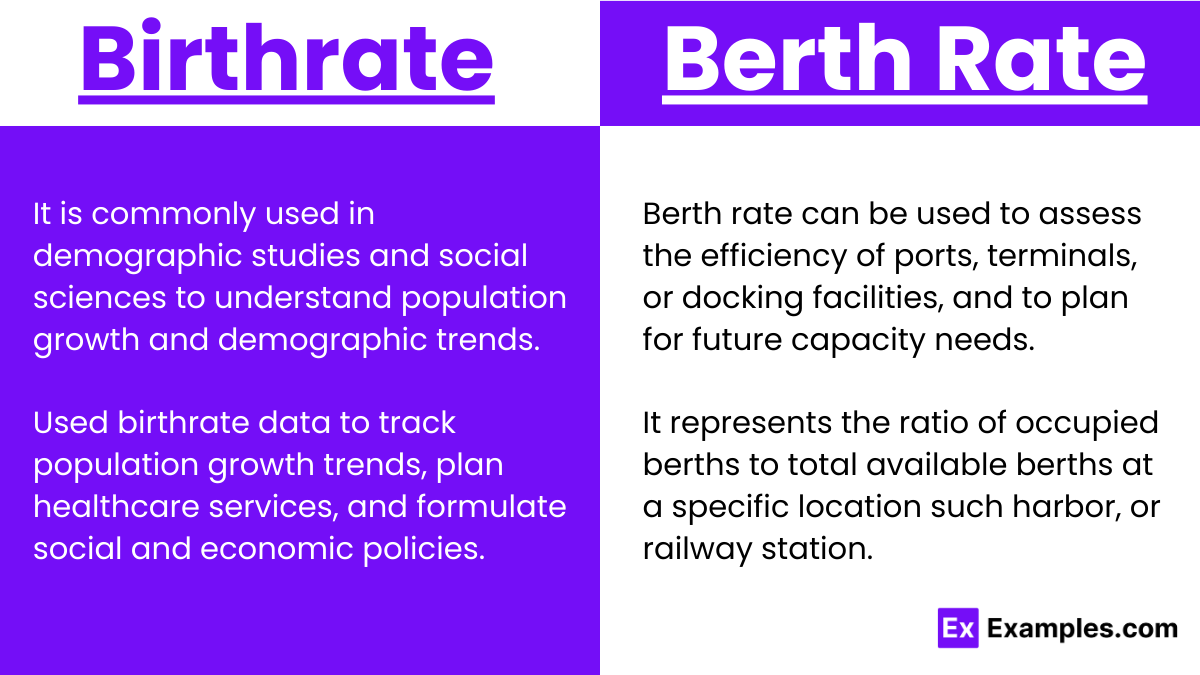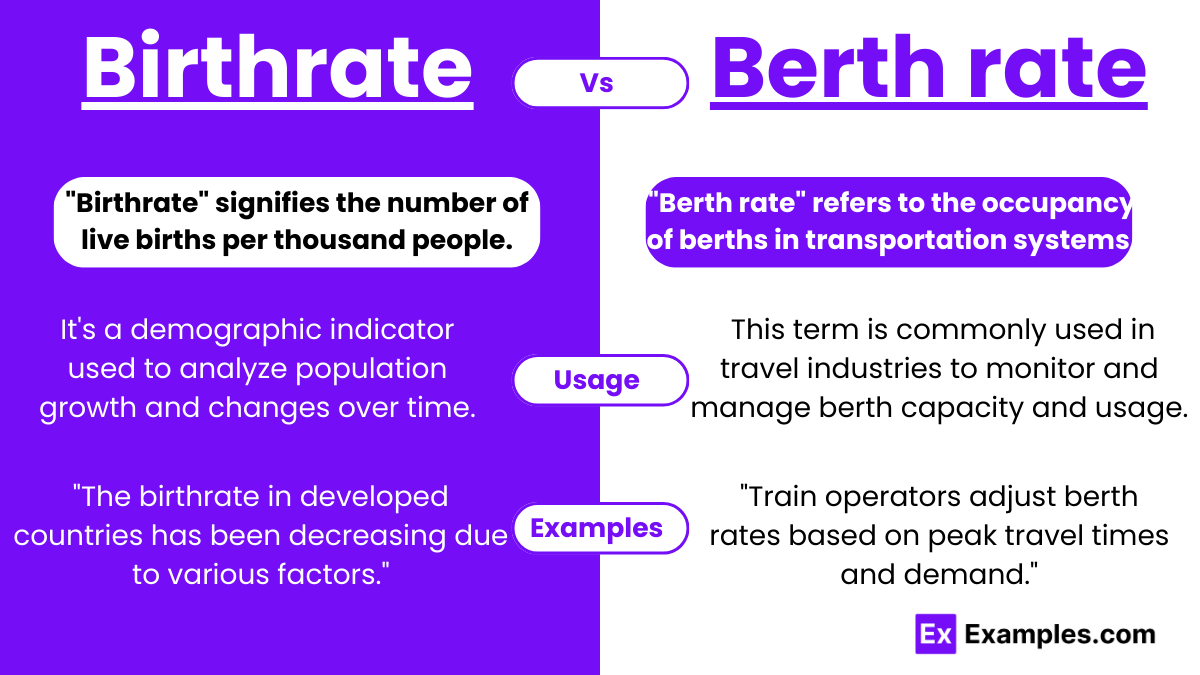Birthrate vs Berth rate
The terms “birthrate” and “berth rate” may appear similar at first glance, but their meanings couldn’t be more distinct. “Birthrate” refers to the number of births per thousand individuals in a population within a given time frame, while “berth rate” pertains to the availability or occupancy of berths, particularly in transportation contexts. Let’s delve into the nuances between these two terms and provide mnemonic aids for remembering their differences.
Birthrate and Berth Rate – Meanings
- “Birthrate” functions as a noun and signifies the number of live births per thousand people in a population over a specified period. It is a crucial demographic indicator used in assessing population growth, fertility rates, and societal trends.
- “Berth rate,” on the other hand, also functions as a noun but refers to the availability, utilization, or occupancy of berths in various transportation systems, such as ports, marinas, or train sleeping compartments. It is essential for managing logistics, planning, and optimizing resource allocation within transportation networks.
Summary
The term “birthrate” refers to the number of births per unit of population over a specified period, typically measured per 1,000 or 1,000,000 people. It indicates the fertility level within a population. “Berth rate” pertains to the availability or occupancy of berths, which are designated spaces for vessels like ships or boats to dock or anchor. The berth rate indicates the utilization or occupancy level of these spaces within ports or harbors.
How to Pronounce Birthrate and Berth Rate
- Birthrate: Pronounced as /ˈbɜrθˌreɪt/ (rhymes with “earth-rate“).
- Berth Rate: Pronounced as /bɜrθ reɪt/ (rhymes with “worth rate“).
Differences between Birthrate and Berth Rate
| Aspect | Birthrate | Berth Rate |
|---|---|---|
| Definition | Refers to the number of live births per thousand individuals in a population | Denotes the availability, occupancy, or utilization of berths in transportation systems |
| Nature | Pertains to demographic indicators and population dynamics | Concerns logistics, resource management, and transportation infrastructure |
| Usage | Used in demographic studies and population analysis | Applied in transportation planning, port management, and logistics |
| Application | Relevant for assessing population growth, fertility rates, and societal trends | Crucial for managing berth allocations, optimizing port operations, and logistics planning |
| Physical Action | Focuses on human reproduction and population dynamics | Involves the utilization and management of physical spaces within transportation systems |
| Noun | Primarily used as a noun | Primarily used as a noun |
How to Remember the Difference between Birthrate and Berth Rate
When distinguishing between the two:
- Birthrate: Recall the “i” in “birthrate” as representing “individuals” or “population,” emphasizing its connection to demographic metrics.
- Berth Rate: Think of the “e” in “berth rate” as standing for “availability” or “occupancy,” highlighting its relevance to the utilization of transportation infrastructure.
How to Use Birthrate and Berth Rate

- To use “birthrate” correctly: Analyze demographic data to determine the number of live births per thousand individuals in a population over a specified period. The term “birthrate” refers to the number of births per unit of population over a specific period, usually measured per 1,000 or 1,000,000 people. It’s a demographic indicator used to analyze population growth and changes over time.
- To use “berth rate” appropriately: Assess the availability, occupancy, or utilization of berths within transportation systems like ports, marinas, or train compartments. “Berth rate” typically pertains to the availability or occupancy of berths, particularly in transportation or maritime contexts. It indicates the rate at which berths, which are spaces for vessels to dock or moor, are occupied or utilized. This term is commonly used in logistics, shipping, and travel industries to monitor and manage berth capacity and usage.
When to Use Birthrate and Berth Rate
Birthrate:
- The country’s birthrate declined significantly over the past decade.
- Demographers study birthrates to understand population dynamics and fertility trends.
- A low birthrate may have implications for future workforce demographics and social welfare systems.
Berth Rate:
- The port authority monitors berth rates to optimize vessel traffic and resource allocation.
- During peak travel seasons, the berth rate at marinas often reaches full capacity.
- Train operators adjust ticket prices based on berth availability and demand for sleeper compartments.
Examples – Birthrate and Berth Rate

Birthrate Examples:
- The birthrate in developed countries has been decreasing due to various socioeconomic factors.
- Governments implement policies to encourage higher birthrates to offset aging populations.
- The region experienced a surge in birthrate following improved healthcare infrastructure and maternal care services.
- he birthrate in developed countries has been decreasing due to factors like increased access to contraception and delayed marriages.
- A high birthrate can strain resources such as healthcare and education systems in a country.
- Governments often implement policies to encourage or discourage birthrates, aiming for a balance in population growth.
Berth Rate Examples:
- The berth rate at the harbor exceeded capacity during the holiday season, leading to temporary closures for incoming vessels.
- Marinas along the coast experienced high berth rates during the summer months, necessitating advanced reservations for boat owners.
- Train operators adjust berth rates based on peak travel times and demand for sleeper compartments.
- The berth rate at the marina increased during peak tourist season, reflecting higher demand for boat docking spaces.
- Shipping companies negotiate berth rates with port authorities as part of their operational expenses.
- Ports may adjust berth rates based on factors like vessel size, duration of stay, and services provided.
Synonyms
| Birthrate Synonyms | Berth Rate Synonyms |
|---|---|
| Fertility rate | Docking fee |
| Natality rate | Mooring charge |
| Reproduction rate | Dockage fee |
| Population growth | Harbor tariff |
| Childbearing rate | Port dues |
Exercise
- The nation’s declining ____________ raised concerns about future demographic trends.
- The port authority implemented strategies to optimize ____________ allocation for incoming vessels.
- Sociologists study ____________ to understand societal shifts and family planning behaviors.
- During the peak travel season, the ____________ at the marina reached maximum capacity.
- Governments analyze ____________ data to develop policies addressing population dynamics.
Answers
- Birthrate
- Berth rate
- Birthrate
- Berth rate
- Birthrate
FAQ’S
Is Birth Rate One or Two Words?
Birth rate is typically considered as two separate words when used in writing. It refers to the number of births per 1,000 people in a given population.
Are Fertility Rate and Birth Rate the Same?
No, fertility rate measures the average number of children per woman, while birth rate counts the number of births per 1,000 people in a population.
What State in the US Has the Highest Birth Rate?
As of recent data, Utah consistently maintains one of the highest birth rates in the United States, followed by states like Alaska and Texas.
Which Country Has the Highest Fertility Rate?
Niger, in West Africa, typically ranks highest globally in terms of fertility rate, with an average of over 7 children per woman.


